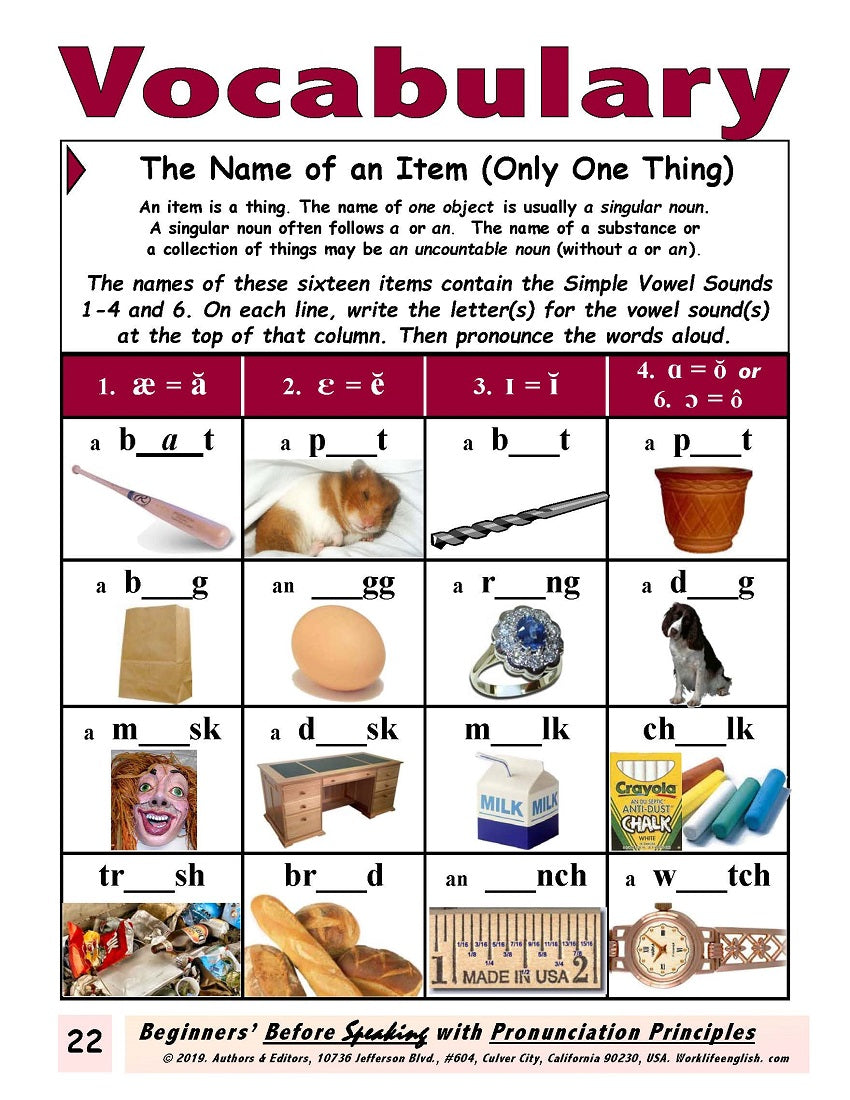1
/
of
5
Work/Life English
E-01.01 Focused on Simple Vowel Sounds, Name & Classify Singular & Plural Nouns
E-01.01 Focused on Simple Vowel Sounds, Name & Classify Singular & Plural Nouns
Regular price
$3.00 USD
Regular price
Sale price
$3.00 USD
Unit price
/
per
Part One-1 (Name & Classify Items with Simple Vowel Sounds & Spellings): Talk About Things, from Beginners’ Before Speaking with Pronunciation Principles, pages 19-29+ Suggested Answers for Activities on pages 22-26
12 pages
Who It’s For: American-English Teachers & Helpers of Beginners Who Want to Integrate Accurate Pronunciation of Simple Vowel Sounds with the Naming & Classifying of Items
Why It’s Useful: At the start of systematic instruction & practice in Oral Language Skills, it helps to focus on one aspect of Pronunciation at a time—in meaningful contexts. Newcomers to spoken American English might need or want to begin with Vowel Sounds & Spellings, in particular the Simple Vowels often written with one letter (a, e, i, o, u) in one-syllable CVC (Consonant-Vowel-Consonant) Vocabulary. This segment shows and tells how to say (and spell) useful words in practical situations. The real-life linguistic Competencies it helps text users to develop are Naming & Classifying Items.
What You’ll Do:
[1] Look over the visuals & listings in the Part One Opener: Talk About Things. Note that while its pedagogy regarding articulation of sounds is centered on (Simple, Complex, All) Vowels, the Vocabulary & Content of its three Divisions 1, 2, 3 is intended to help text users Name & Classify, Describe, and Compare Items.
[2] Page 20 introduces novice American-English speakers to a “Mouth Diagram.” It explains that “for the pronunciation of vowel sounds, no parts of the mouth touch.” It shows positions for articulation of 9 “Simple” (also called “Lax” or “Short”) Vowel Sounds represented by the symbols / Ï= ², E= Ç, I= Ñ, A = Ú, ¿ = ô, O = Ú, U= ooB, ä(r) = õ(r) / in relation to one another and parts of the mouth. Next comes instruction in how the lips look when saying them—and how to spell them. With aural / oral examples of the Sounds + Key Words containing them, learners grow to comprehend, distinguish, and clearly pronounce Simple Vowel Sounds in context.
[3] On pages 22-25 of Part One-1, text users associate sounds with letters in labels for Singular vs. Plural Items. They practice articulating these and comparable words in Conversations that “Name & Classify.” In more demanding “Challenge Activities,” progressing language learners get to apply acquired principles to a lot more (illustrated) vocabulary—grouped items to designate, explain, and categorize.
[4] Correct answers and suggested language to use are in attached Answer Key pages.
Couldn't load pickup availability










